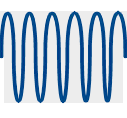Spring:
Mechanical device that can store energy when it is deformed and return an equivalent amount of energy when it is released.

Compression spring:
Spring which reacts to a compressive axial force which tends to decrease the length of the spring. The compression springs are also called pressure springs. They consist of a wire with a circular, square or rectangular cross section, wound in a helix around an axis, with coils that do not touch. The helical compression springs are generally cylindrical in shape, although there are other forms, such as for example conical, biconical (convex, barrel springs; concave: hourglass springs) or tapered.

Tension spring:
Spring which reacts to an axial force which tends to extend the length of the spring, with or without initial tension. Tension springs are also called pulling or drawing springs Tension springs are usually made from circular cross section wire, wrapped helically around an axis, with coils in contact or not.

Torsion Spring:
Spring which reacts to a torsional moment around the spring’s longitudinal axis. They are usually made up of circular cross section wire, wrapped helically around an axis and with ends suitable for transmitting torque.

Torsion bar:
torsion spring composed of rectilinear bars or rods with a defined section.

Belleville washers:
Spring washer shaped like a truncated cone, with a constant material thickness, capable of withstanding high loads with greatly reduced deflection.

Number of active coils:
Number of coils used to calculate the maximum deflection of the spring.

Total number of coils (of the compression springs):
Number of active coils plus the coils that form the ends.

Maximum deflection:
Movement of the spring’s free position to that of the maximum load.

Force:
Force exerted by the spring in deformed condition compared to free state, in order to reproduce or modify a movement, or to maintain a balanced system of forces.

Wind direction:
Direction in which the coils wind, viewed by an observer placed at one end of the spring. The winding direction is right (RH) if the coil moves away winding clockwise; left (LH) if the coil moves away winding counterclockwise.

Free length :
Total length of a spring on which no external force is applied.

Solid length:
Overall length of a compression spring when the coils are completely in contact. It is also called the spring’s packed length.

Slackening:
Decrease in reaction forces of a deformed spring in a fixed position, depending on time.

Spring load:
Force exerted by or on a spring when it is pulled or compressed to a defined length.

Spring pitch:
Distance from centre to centre of the wire in adjacent active coils.

Stress relief tempering:
Suppression of the residual stresses generated by the spring forming process, by means of a low temperature heat treatment carried out after winding or bending. Depending on the heat treatment carried out, stress relief tempering is also called: “stress distension”, “stabilisation of loads”, “tempering”, “annealing”.

Initial tension:
Force induced in the tension springs during winding. It keeps the coils close; so that the coils start to open a force greater than the initial one must be applied to the tension spring.


